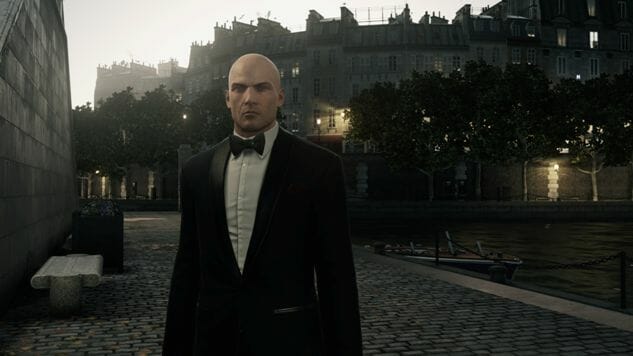
Between ostentation and subtlety, Hitman’s Agent 47 has always represented a clash. The world’s greatest assassin, he is consummately able to blend into surroundings and kill without leaving a trace. On the contrary, the bar code tattooed to the back of his head makes him stick out in any crowd. 47 is a chameleon—genetically engineered using DNA from around the world, he’s endowed with facial features which are not strictly out of place anywhere. But he’s also an outsider. Created in a lab, he exists in human society as an oddity, a rogue, a non-person.
More than any of its predecessors, this year’s Hitman game understands 47: his dialogue, his appearance and his physicality betray an individual simultaneously anonymous yet extraordinary. He is intelligent and calm, but also capable of sudden and efficient violence. He knows the world, its languages, its customs, but nevertheless enters and exits it as quickly as possible, all the time enacting damage on the very high society to which he seemingly belongs. One is reminded of James Bond when playing Hitman, particularly in regards to the deep blue tuxedo worn by 47 during his mission to Paris(and bearing in mind an inspiring article by Robert Rath).On the posters for Skyfall, Daniel Craig was dressed in a similar blue suit. But where Craig is incapable of fitting in anywhere other than a fight (every time he lifts his Martini in Casino Royale, he looks so consternated he might crush the glass) 47 filters through his environments—an Italian cittadina, a world-class hotel, the Swedish embassy to Morocco—like a young Sean Connery. Whether black tie or a white polo shirt, 47’s clothes hug his body, accentuating not just musculature, but his exactness and attention to detail. Educated and unflappable, such immaculate tailoring speaks of a man simultaneously self-possessed and at ease with the world, fluent in all of fashion, sex and society. 47’s designer sunglasses belong dangling from his shirt collar, as he orders a cocktail in exact dialect. His broad shoulders are weapons, always visibly drawn and ready to be swung.
It’s in 47’s most minor movements, however, that we truly observe his character. The way he simply picks something up, be it a key, a vial of poison or a gun tells us he is both aware that he may suddenly be discovered and ousted from the human world, and wholly assured of his dominion. Without stopping walking—and his walk is a forceful, straight-backed stride—47 collects items with a brisk sleight of hand. Again, one is reminded of the great spy movies, specifically The Bourne Identity, wherein Matt Damon collects everything he needs to evade pursuers, be it shotgun shells, a fire extinguisher or a map of a building’s emergency escape route, without slowing his pace. Our sense of 47 becomes conflicted. When the situation is calm, his rapid and faultless gathering of objects seems anticipatory, as if he expects to be compromised any moment. When circumstances are more fraught, his very same actions convey cool-headedness and professionalism. Thus, 47, and his audience, are perpetually tightly coiled. As he secrets away a knife from a hotel kitchen, we prepare ourselves for the worst. When he unflinchingly collects a key card from an unconscious porter, we are confident to face anybody.
Thus 47’s unique appeal. He isn’t bashful, like Nathan Drake, or sorrowful, like John Marston. He’s potent. He’s steely. Between his preternatural capability to understand and predict people, and inability to truly be a person, lies a conflict, and it’s expressed through his clothes and body language—47 is both dressed to fit in but always stands out, expecting the worst but prepared for the best. Though among people—often literally, in huge crowds—47 is nevertheless perpetually above them, physically and mentally out of reach. His closeness to women in the two films, Hitman and Hitman: Agent 47, is contradictory to the inaccessibility which makes 47 intriguing. The games, particularly this year’s, do go to lengths to assure players 47 is not, as his piercing blue eyes might imply, emotionally devoid—on the contrary, he wants into the world. He plays the drums, he owns a canary, he knows how to mix a drink. But to 47 people are either hostile or too simplistic. Marching through restricted areas in an ostentatious tuxedo, killing without discomposure, 47 is arrogant and aloof. Like Bond, wounded by the deaths of his parents, 47 exacts revenge on the world by dominating it completely. The way he collects and scurries away weapons, as well as stark ability, betrays almost reluctance. Retrieving that knife is a dirty act, which will eventually drive 47 even further off the fringe of society, and so he gets it over with quickly.
To describe these complexities using such minor actions and details represents nuanced understanding of character design, character design being one of the game-making disciplines most often abused by its practitioners. Without oversized weapons, ludicrous hair or otherworldly physical strength, 47 nevertheless possesses an unattainable cool. His voice is not gravelly, he carries no physical scars, he gives no soliloquies, but emotional conflict, should one look carefully, as they must when playing Hitman, is still acutely felt.
Ed Smith is a writer from the UK. You can follow him on Twitter @mostsincerelyed and find more of his work at bulletpointsmonthly.com.